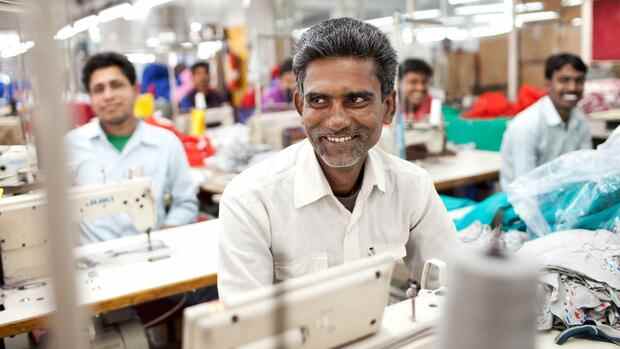Bangkok Overcrowded hospitals, empty oxygen tanks and parking lots that were makeshiftly converted into open-air crematoriums: In May, the images of India’s Covid catastrophe went around the world.
Half a year later, there are completely new impressions from Asia’s third largest economy: the daily number of infections has fallen by 97 percent since the record high, more than a billion vaccine doses have been administered, and the economy is growing faster than in any other G20 country.
The government in New Delhi sees itself in an excellent position to position the subcontinent as Asia’s leading alternative to China in the competition for investors.
“In some ways, our economy is now stronger than it was before the pandemic,” said economist Sanjeev Sanyal, chief economic advisor at the Indian Ministry of Finance, at the Handelsblatt event Asia Business Insights. His country is not just a few good years ago with double-digit growth. “Even after that, we will be able to maintain very high growth rates – possibly the highest in the world.”
Top jobs of the day
Find the best jobs now and
be notified by email.
These prospects are attracting more and more international companies who are increasingly integrating India into their supply chains – not least to reduce their dependence on China.
For the past fiscal year, which ended in March, the 1.4 billion-inhabitant country reported record foreign direct investments: Despite the corona crisis, they rose by ten percent to 81.7 billion dollars. “It is very encouraging for me to see that international investors are recognizing the opportunities in India,” said Surendra Rosha, Head of Asia at Bank HSBC.
India is likely to lead the growth rankings next year as well
Rosha highlighted the rapid growth of the Indian start-up scene, which this year produced several dozen so-called unicorns, i.e. start-ups with a valuation of more than a billion dollars. International venture capitalists recently turned to India’s technology sector after stricter regulation in China clouded prospects there.
The HSBC manager also sees business-friendly reforms by the Indian government under Prime Minister Narendra Modi as the reason for the influx of investors, such as the lowering of corporate taxes and planned infrastructure investments of 1.4 trillion dollars in the years 2019 to 2023.
NAccording to a forecast, India will be well ahead of China in the coming year with an increase of 8.5 percent economic growth.
(Photo: Lonely Planet Images / Getty Images)
The measures are already driving growth: According to forecasts by the International Monetary Fund (IMF), India’s gross domestic product will grow by 9.5 percent this year – faster than in any other major economy.
Government advisor Sanyal believes the gains will be even higher. The rapid increase is mainly due to the weak previous year, when the country’s economy shrank by more than seven percent due to extremely strict corona lockdowns. But according to the forecasts of the IMF economists, India will continue to lead the growth rankings in the coming year – and with a plus of 8.5 percent it will be well ahead of China.
The high growth opportunities are noticeable in the boardrooms of the corporations: According to a study published in September by the consulting firm Deloitte, almost every second of 1200 international companies surveyed are planning to expand investments in India or to make them for the first time. This is often done as part of a so-called “China plus one” strategy, according to which companies have been building up a second mainstay in Asia alongside the People’s Republic for years.
Delivery Hero is growing in Southeast Asia
Vietnam is also benefiting from these diversification efforts. The country with a population of 100 million has recently attracted significant parts of the supply chains in the electronics and fashion industries. “German companies have been investing there for years and are continuously expanding trade relations,” said Roland Busch, Chairman of the Asia-Pacific Committee of German Business. The free trade agreement between the EU and Vietnam, which came into force last year, is a further driving force behind this development.
But the rapid relocation of production to Vietnam has recently caused massive problems: Due to a coronavirus outbreak, many factories have had to close in recent months or have only been able to maintain operations in a makeshift manner. Delivery delays affected corporations such as Apple, Adidas and Nike – the US sporting goods manufacturer reported a ten-week production downtime.
The pandemic also still harbors risks in other countries in the region: Despite considerable progress in the vaccination campaigns compared to the first half of the year, less than half of the population in most of the emerging countries of South and Southeast Asia is fully immunized. The risk of new outbreaks remains.
The Dax group Delivery Hero, which is active with its delivery services in the region in twelve markets from Pakistan to the Philippines, was able to grow despite the uncertainties. The Foodpanda brand, which is primarily present in Asia, received 2.5 million orders per month three years ago, said CEO Niklas Östberg. There are now 70 million.
Overall, the Asian business accounts for almost half of sales. With new offers such as the fast delivery of groceries and household goods, Östberg wants to further expand the business in the metropolises of the continent. He was optimistic that this will succeed: “From our point of view, Asia is a region of opportunities.”
More: A new unicorn every week – that’s how fast India’s start-up scene is rushing away from the competition
